Basic Information
-
Targeting strategy

-
Gene targeting strategy for B-hB7-H4 mice. The exons 3-5 of mouse B7h4 gene that encodes the extracellular region coding sequences were replaced by human B7-H4 exons 3-5 in B-hB7-H4 mice.
-
mRNA Expression Analysis

-
 Strain specific analysis of B7-H4 gene expression in wild type and B-hB7-H4 mice by RT-PCR. Mouse B7-h4 mRNA was detectable only in ovary of wild type mice (+/+). Human B7-H4 mRNA was detectable only in homozygous B-hB7-H4 mice (H/H) but not in wild type mice.
Strain specific analysis of B7-H4 gene expression in wild type and B-hB7-H4 mice by RT-PCR. Mouse B7-h4 mRNA was detectable only in ovary of wild type mice (+/+). Human B7-H4 mRNA was detectable only in homozygous B-hB7-H4 mice (H/H) but not in wild type mice. -
Protein Expression Analysis

-
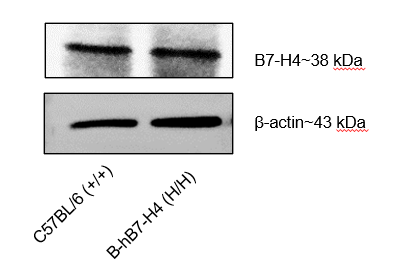
Strain specific B7-H4 expression analysis in homozygous B-hB7-H4 mice by western blot. Testis tissue was collected from wild type mice (+/+) and homozygous B-hB7-H4 mice (H/H) and analyzed by western blot with anti-B7-H4 antibody. Mouse B7-H4 was detectable in wild type mice. Human B7-H4 was detectable in homozygous B-hB7-H4 but not in wild type mice. Anti-B7-H4 antibody is crossly reactive with B7-H4 in human and mice.
-
Analysis of spleen leukocytes cell subpopulations in B-hB7-H4 mice

-

Analysis of spleen leukocyte subpopulations by FACS. Splenocytes were isolated from female C57BL/6 and B-hB7-H4 mice (n=3, 7-week-old). Flow cytometry analysis of the splenocytes was performed to assess leukocyte subpopulations. A. Representative FACS plots. Single live cells were gated for the CD45+ population and used for further analysis as indicated here. B. Results of FACS analysis. Percent of T cells, B cells, NK cells, dendritic cells, granulocytes, monocytes and macrophages in homozygous B-hB7-H4 mice were similar to those in the C57BL/6 mice, demonstrating that introduction of hB7-H4 in place of its mouse counterpart dose not change the overall development, differentiation or distribution of these cell types in spleen. Values are expressed as mean ± SEM.
-
Analysis of spleen T cell subpopulations in B-hB7-H4 mice

-
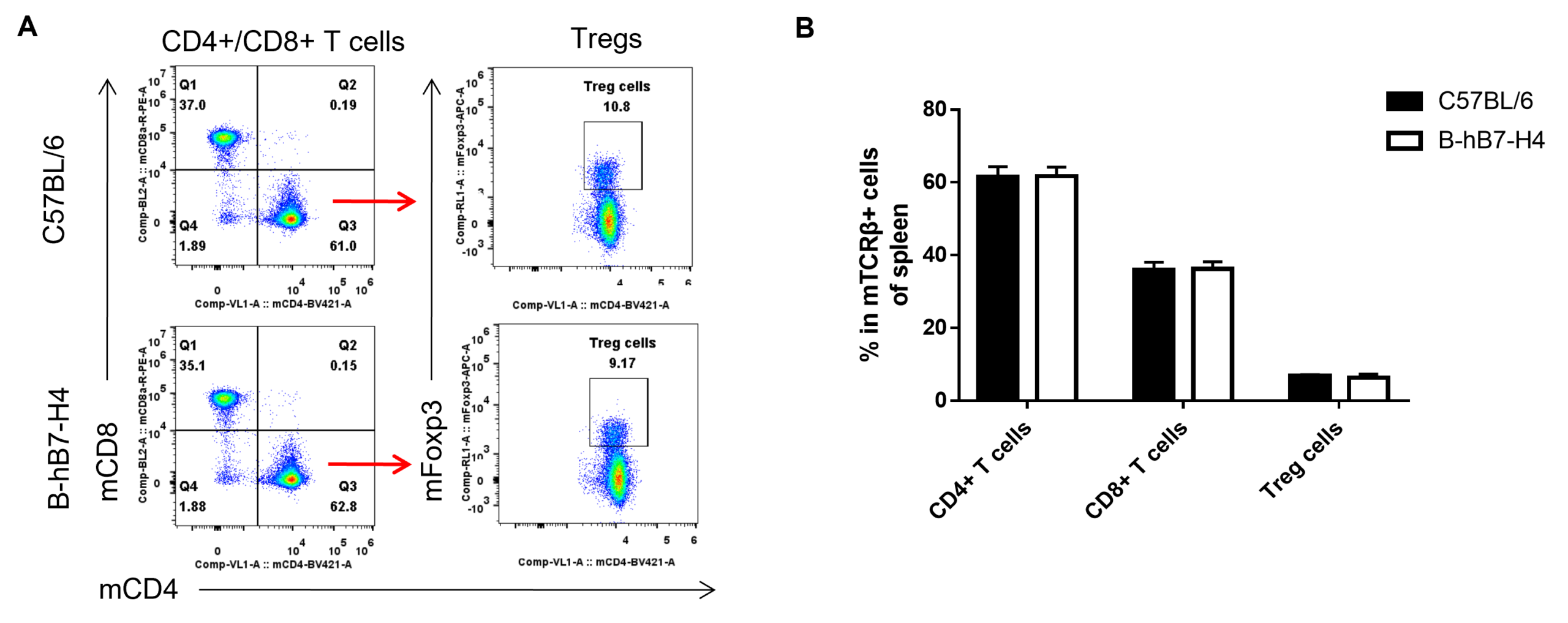
Analysis of spleen T cell subpopulations by FACS. Splenocytes were isolated from female C57BL/6 and B-hB7-H4 mice (n=3, 7-week-old). Flow cytometry analysis of the splenocytes was performed to assess leukocyte subpopulations. A. Representative FACS plots. Single live CD45+ cells were gated for TCRβ+ T cell population and used for further analysis as indicated here. B. Results of FACS analysis. The percent of CD4+ T cells, CD8+ T cells, and Tregs in homozygous B-hB7-H4 mice were similar to those in the C57BL/6 mice, demonstrating that B7-H4 humanized does not change the overall development, differentiation or distribution of these T cell subtypes in the spleen. Values are expressed as mean ± SEM.
-
Analysis of blood leukocytes cell subpopulations in B-hB7-H4 mice

-

Analysis of blood leukocyte subpopulations by FACS. Blood were isolated from female C57BL/6 and B-hB7-H4 mice (n=3, 7-week-old). Flow cytometry analysis of the blood was performed to assess leukocyte subpopulations. A. Representative FACS plots. Single live cells were gated for the CD45+ population and used for further analysis as indicated here. B. Results of FACS analysis. Percent of T cells, B cells, NK cells, dendritic cells, granulocytes, monocytes and macrophages in homozygous B-hB7-H4 mice were similar to those in the C57BL/6 mice, demonstrating that B7-H4 humanized does not change the overall development, differentiation or distribution of these cell types in the blood. Values are expressed as mean ± SEM.
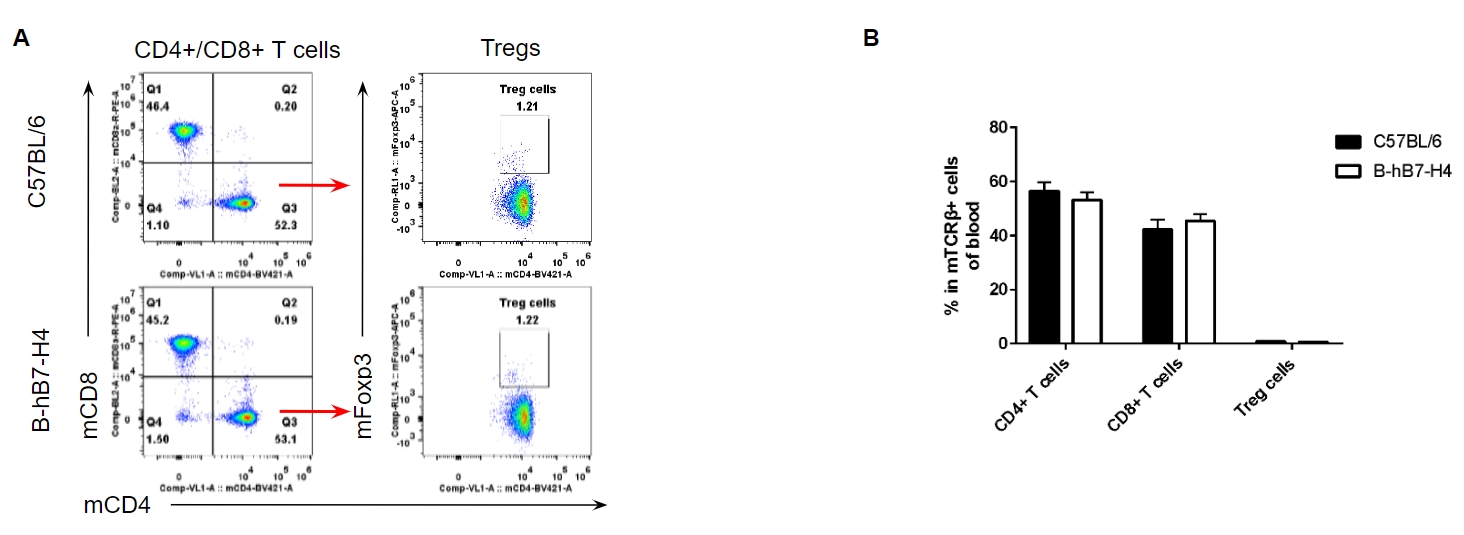
Analysis of blood T cell subpopulations by FACS. Blood were isolated from female C57BL/6 and B-hB7-H4 mice (n=3, 7-week-old). Flow cytometry analysis of the blood was performed to assess leukocyte subpopulations. A. Representative FACS plots. Single live CD45+ cells were gated for TCRβ+ T cell population and used for further analysis as indicated here. B. Results of FACS analysis. The percent of CD4+ T cells, CD8+ T cells, and Tregs in homozygous B-hB7-H4 mice were similar to those in the C57BL/6 mice, demonstrating that B7-H4 humanized does not change the overall development, differentiation or distribution of these T cell subtypes in the blood. Values are expressed as mean ± SEM.
-
Analysis of Lymph node leukocytes cell subpopulations in B-hB7-H4 mice

-
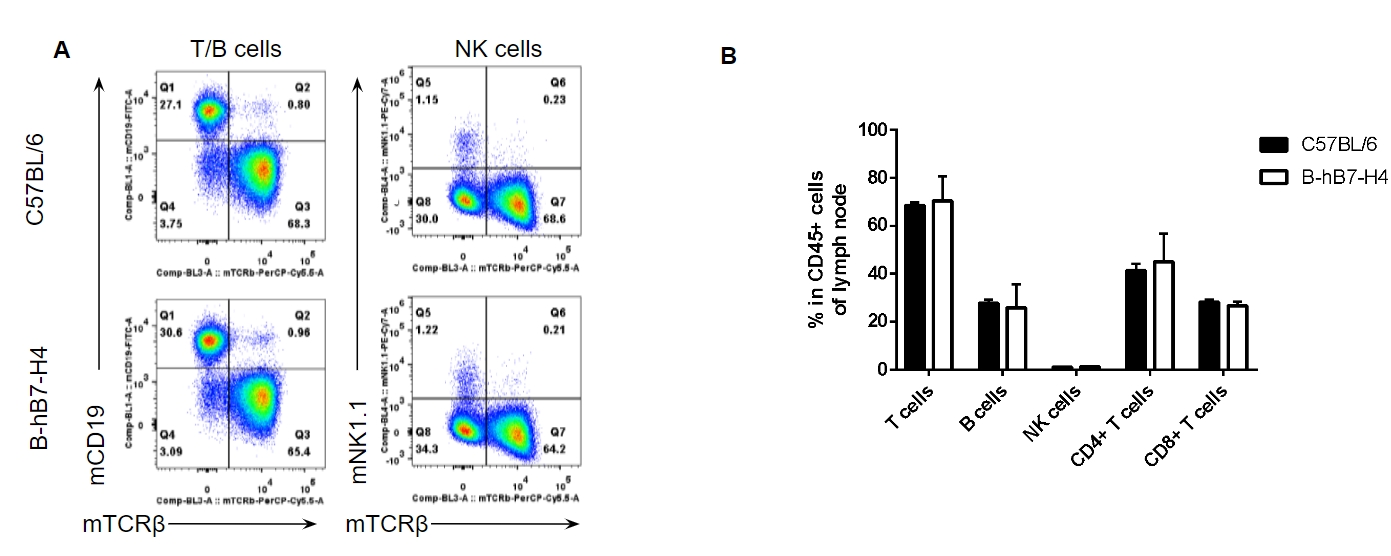
Analysis of lymph nodes leukocyte subpopulations by FACS. lymph nodes were isolated from female C57BL/6 and B-hB7-H4 mice (n=3, 7-week-old). Flow cytometry analysis of the leukocytes was performed to assess leukocyte subpopulations. A. Representative FACS plots. Single live cells were gated for the CD45+ population and used for further analysis as indicated here. B. Results of FACS analysis. Percent of T cells, B cells, NK cells in homozygous B-hB7-H4 mice were similar to those in the C57BL/6 mice, demonstrating that B7-H4 humanized does not change the overall development, differentiation or distribution of these cell types in the lymph node. Values are expressed as mean ± SEM.
-
Analysis of Lymph node T cell subpopulations in B-hB7-H4 mice

-
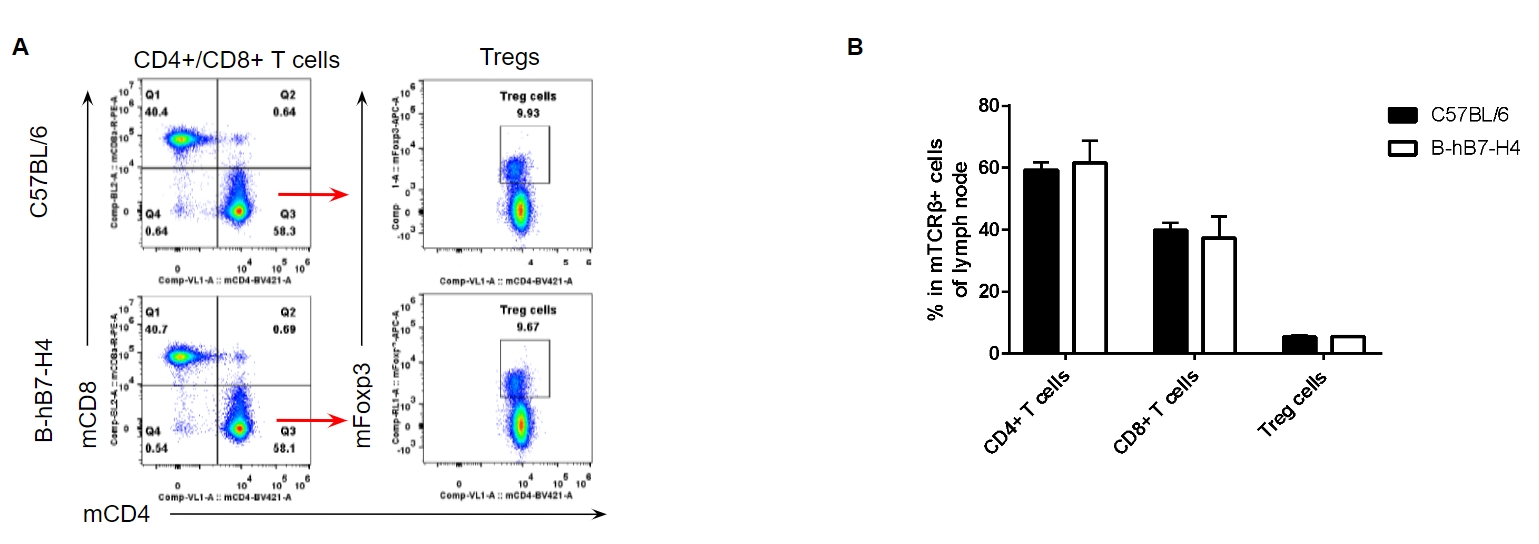
Analysis of lymph nodes T cell subpopulations by FACS. lymph nodes were isolated from female C57BL/6 and B-hB7-H4 mice (n=3, 7-week-old). Flow cytometry analysis of the leukocytes was performed to assess leukocyte subpopulations. A. Representative FACS plots. Single live CD45+ cells were gated for TCRβ+ T cell population and used for further analysis as indicated here. B. Results of FACS analysis. The percent of CD4+ T cells, CD8+ T cells, and Tregs in homozygous B-hB7-H4 mice were similar to those in the C57BL/6 mice, demonstrating that B7-H4 humanized does not change the overall development, differentiation or distribution of these T cell subtypes in the lymph node. Values are expressed as mean ± SEM.
-
In vivo Efficacy of Anti-Human B7-H4 Antibody

-
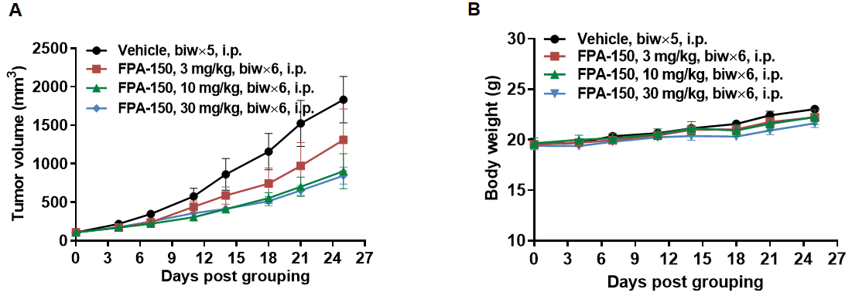
Antitumor activity of an anti-human B7-H4 antibody in humanized B-hB7-H4 mice. Humanized murine colon cancer B-hB7-H4 MC38 cells (3ⅹ106) were subcutaneously implanted into homozygous B-hB7-H4 mice (female, 8-week-old, n=6). B-hB7-H4 mice were grouped when tumor volume reached approximately 100 mm3, at which time FPA-150 (anti-human B7-H4 Ab, in house) was administered at doses and schedules indicated in panel A. (B) Body weight changes during treatment. As shown, FPA-150 inhibited tumor growth without negatively impacting body weight changes, demonstrating that B-hB7-H4 mice provide a powerful preclinical model for in vivo evaluation of anti-human B7-H4 antibodies. Values are expressed as mean ± SEM.
-
Poster

-
AACR 2022: A Humanized Mouse Model of the Promising Immune Checkpoint Molecule B7-H4


